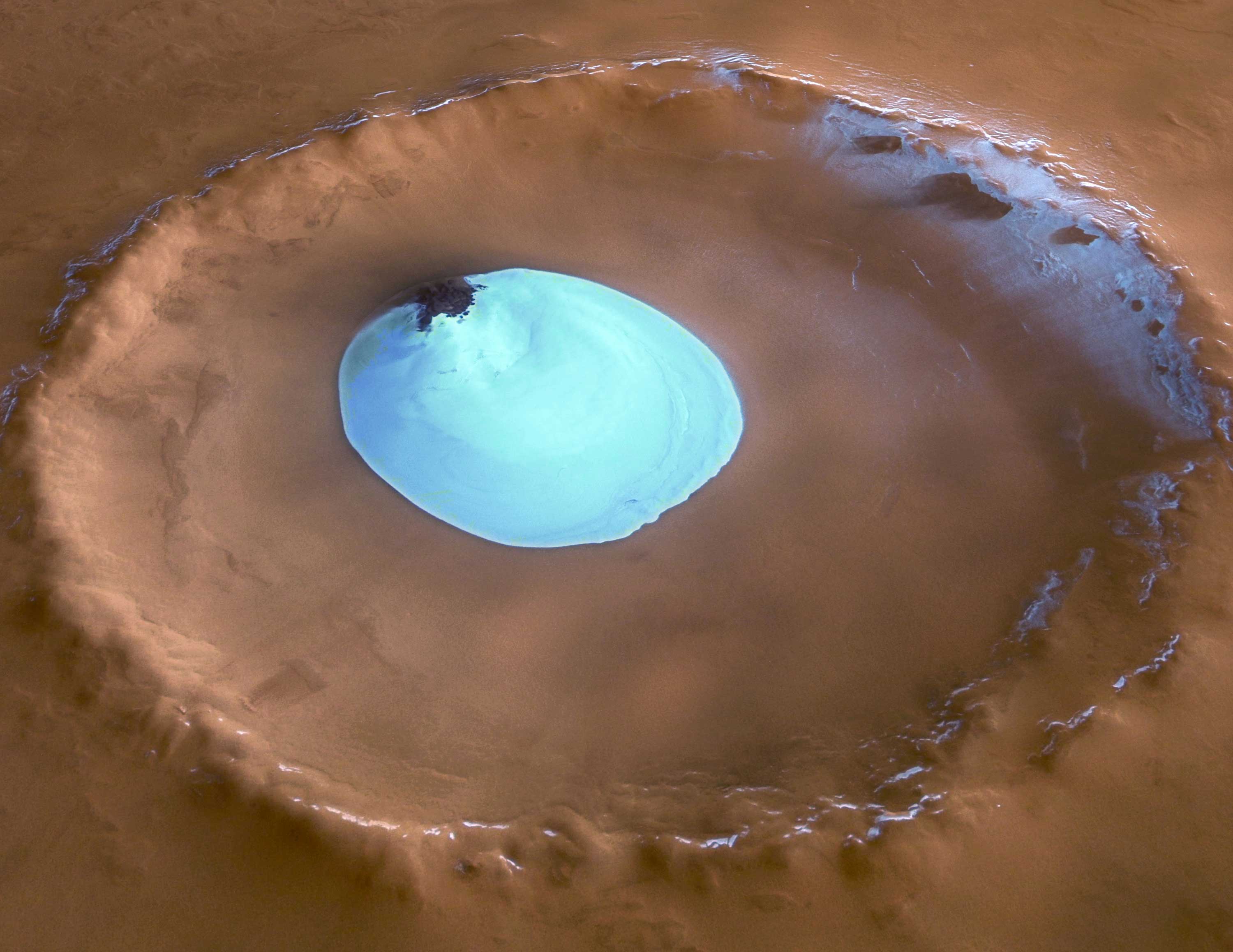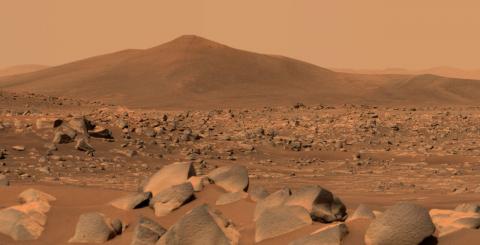Mars ice could support photosynthetic life, study finds
US researchers have published a model showing that ice in the mid-latitudes of Mars could allow photosynthetic life to develop. Its thickness and composition would attenuate harmful ultraviolet radiation, but allow sufficient visible light to pass through. The work is published in the journal Communications Earth & Environment.

César Menor - vida fotosintética hielo Marte EN
César Menor Salván
Astrobiologist and lecturer of Biochemistry at the University of Alcalá
The paper argues that it is possible that there are areas on Mars where ultraviolet radiation destructive to organic molecules, such as nucleic acids (DNA), is sufficiently attenuated by layers of ice and dust, yet still allows the light needed for photosynthesis to penetrate.
Such areas, located at mid-latitudes where there is exposed ice on the surface, could be favourable for photosynthetic organisms, which could be a guide for future exploration. There may be microenvironments similar to those found in some terrestrial glaciers, where photosynthetic life could occur.
For me this work has many limitations. Although it is robust and the complex models used make the results clear, it is after all based on terrestrial life and in particular on cyanobacteria, terrestrial photosynthetic bacteria. The model is based on the assumption that potential Martian life could have evolved in the same way as on Earth, with photosynthetic mechanisms, DNA and resistance to ultraviolet radiation similar to that of terrestrial life. Moreover, it is highly unlikely that there is life on Mars today, so if any photosynthetic life existed, it is likely to have been in the distant past, under very different environmental conditions, and it could have evolved differently from terrestrial photosynthesis.
The work is purely theoretical, based on a terrestrial analogue, so exploration could show that such a model is not really possible on Mars. Moreover, they do not seem to have taken into account effects such as the sublimation of ice at low Martian pressure.
Because of the limitations I have discussed, it does not seem that the implications of this work will be very significant, although these calculations should be taken into account in future Mars exploration, particularly in relation to the presence of exposed or very shallow ice.
Jesús Martínez Frías - vida fotosintética Marte EN
Jesús Martínez Frías
Planetary geologist and astrobiologist at the IGEO (CSIC-UCM). Academician of the Royal Academies of Sciences and Doctors of Spain. President of the Planetary Geology Commission of the Geological Society of Spain and of the Spanish Network of Planetology and Astrobiology.
It is a very interesting and high quality study that combines different aspects: basically ice, atmosphere, radiation and astrobiological potential, considering comparative modelling on Mars and Earth.
Although some previous studies had already partially addressed this issue, usually the more experimental investigations, carried out theoretically or in planetary environment simulation chambers, had focused on determining the capacity of the Martian regolith to act as a radiation shield.
This work goes further by considering and carrying out a more complex and global analysis, taking into account potentially analogous Earth-Mars zones for modelling experiments, specifically in Greenland.
This study opens, on the one hand, real new perspectives on the possibility of finding habitable areas on Mars, consistent with those of terrestrial photosynthetic organisms, from the radiation point of view. On the other hand, it also considers the problems linked to low temperatures and the existence of liquid water.
The implications of this study are both geological and astrobiological in the Martian cryosphere and should be considered in future robotic or human missions to the red planet.
The study is very well structured and developed. It would be interesting to deepen these topics by covering similar analyses and modelling at different Martian latitudes and complementing them with other mineralogical and geochemical aspects.
Antonio Molina - vida fotosintética Marte EN
Antonio Molina
Planetary geologist specialising in Mars in the Department of Planetology and Habitability at the Centre for Astrobiology (CAB)
In this paper, the authors simulate variations in sunlight as it passes through masses of ice mixed with dust on the surface of the planet Mars. They assess how these changes would affect hypothetical organisms living within the ice, both by reducing radiation levels to bearable levels and by allowing variations in the solar spectrum to still allow photosynthesis-based metabolisms. While this is a relatively simple study that is limited to modelling these energy variations, it does seem thorough and provides a much more detailed assessment than previous studies, which considered uniform energy flux without assessing variations in the spectrum; or which considered pure snow or ice, unable to sufficiently reduce radiation.
The models and assumptions seem adequate, as does their validation with an analogous case, such as the Greenland glacier they present. Although the authors themselves consider the possible uncertainties in these measurements, they are no greater than the differences that might be found between a terrestrial glacier and one found on Mars. It seems that the fit, in any case, is good enough to serve as a reasonable example.
Mars has such a tenuous atmosphere (lacking an ozone layer) that radiation from the Sun reaches the surface with sufficient force to sterilise it for life as we know it. This is why areas below the surface are considered much more habitable, where, at a depth of just a few centimetres, the most devastating effects are neutralised. Although there are endolithic organisms, which live practically inside the rock, being able to use solar radiation as a source of energy is an advantage that must also be taken into account. In this case, the authors calculate that, while snow or ice alone would not be sufficient to dampen the harmful effect of radiation, if this ice is mixed with dust particles (regolith) it would not only be sufficient to slow it down, but would still allow photosynthetic organisms to take advantage of the resulting radiation. The main result is the assessment of where the ‘habitability fringe’ would be in this ice, i.e. at what depth within these Martian glaciers life as we know it could thrive. And they assess this according to where they are at different latitudes, with different Sun inclinations, ice particle sizes and amounts of interstitial dust. These data may help to better delineate the most suitable areas to search for life on Mars in current and future missions.
[In terms of limitations] The work is limited only to studying the effects of non-ionising solar radiation. Additionally, the effect of cosmic rays, which on Earth are limited by a global magnetic field that Mars lacks, should be considered. And while the intense radiation to which the surface of Mars is subjected is an important factor, there are many other factors that limit the habitability of Mars and would need to be considered for a more complete picture. Low atmospheric pressure causes water to sublime, changing from solid to gaseous state directly. The work does not assess how stable the interstitial water in these glaciers would be and that, at least in limited niches, liquid water is found within them is critical.
Another effect of the tenuous Martian atmosphere is that temperature variations between day and night are enormous, changing by tens of degrees in minutes. Although certain salt concentrations and pressure conditions allow for the presence of liquid water, the impact of these variations within the glacier would have to be assessed. Similarly, the chemical composition of this dust is crucial. The paper itself cites that the particles may serve to facilitate the melting of the ice into small ‘bubbles’, but if they contain high concentrations of elements such as perchlorates (of which we believe there may be large quantities), they could make even a physically habitable environment chemically toxic.
Khuller et al.
- Research article
- Peer reviewed
- Modelling



